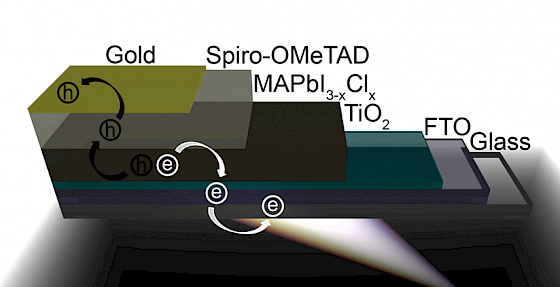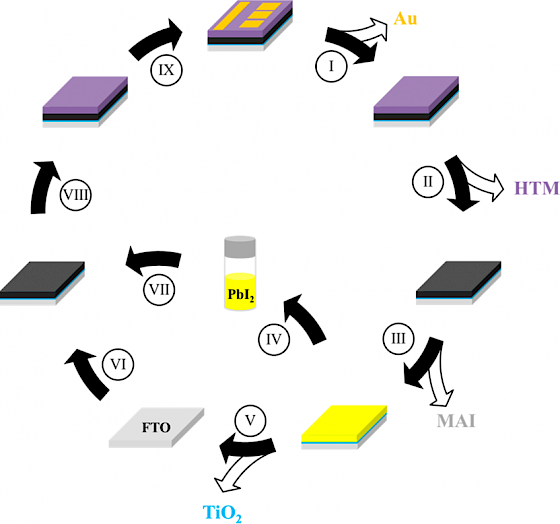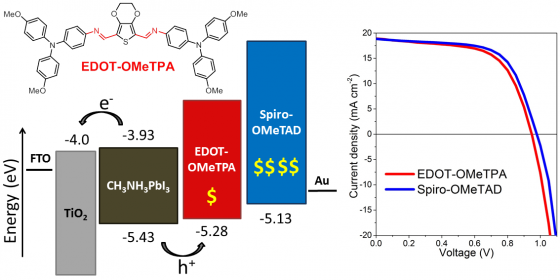Research
Perovskite Solar Cells

Docampo, P., Ball, J. M., Darwich, M., Eperon, G. E. & Snaith, H. J. Efficient organometal trihalide perovskite planar-heterojunction solar cells on flexible polymer substrates. Nature communications 4 (2013).
Solar cells based on perovskite absorbers are the fastest growing photovoltaic technology in history. Since their introduction in early 2008 with a starting point power conversion efficiency of ~4%, they have now since left behind amorphous Silicon and are already achieving efficiencies of over 19%, approaching other industry staples such as CIGS and polycrystalline Silicon. Perovskite solar cells have the potential to become a serious contender for the photovoltaic market due to their already demonstrated high device efficiencies, the low-cost of their starting materials and their compatibility with large-scale, solution processing techniques such as roll-to-roll printing on flexible substrates.
In our group, we have focused our research on the development of novel perovskite materials and deposition methods, with a high emphasis on the elucidation of the working principles behind the assembled photovoltaic devices. The typical device structure prepared in our lab is shown in the scheme below.

Recycling of solar cells
Most perovskite-based solar cells contain lead, which is known to be toxic. Besides the health issues, also international laws force the recycling of electronic waste after their operational lifetime. We published a procedure to remove every layer of the solar cells separately, which gives the possibility to selectively isolate the different materials. In this way the toxic lead can be isolated and reused for making new solar cells. Also the expensive conductive glass (FTO) can be reused several times without losing the efficiency of the solar cells. With our simple recycling procedure, we address both the risk of contamination and the waste disposal of perovskite based solar cells while further reducing the cost of the system. This brings perovskite solar cells one step closer to their introduction into commercial systems.

Hole-transporting materials
Most perovskite-based solar cells make use an organic hole transporting material, termed Spiro-OMeTAD. Even though this material is fully organic, the expensive starting materials, transition metal catalysts and inert reaction conditions required for the synthesis and extensive product purification make its production cost prohibitive.
We develop low-cost alternatives for Spiro-OMeTAD, using simple and clean chemistry. We synthesized a hole transporting material (EDOT-OMeTPA) using Schiff-base condensation chemistry, in which water is the only by-product, making purification very straight forward. EDOT-OMeTPA showed comparable devices performance to state-of-the-art materials, but at a cost which is two orders of magnitude lower.

Petrus M.L., Bein T., Dingemans T.J., Docampo P., “A Low-Cost Azomethine-Based Hole Transporting Material for Perovskite Photovoltaics” J. Mater. Chem. A, (2015), 3, 12159
Other applications
In collaboration with the University of Cambridge, we have developed novel light emitting devices based on perovskite structures. The materials prepared in our group exhibit high photoluminescence quantum yields, which make their application into lighting devices readily achievable.

Tan, Z.-K., Moghaddam, R. S., Lai, M. L., Docampo, P., Higler, R., Deschler, F., Price, M., Sadhanala, A., Pazos, L. M. & Credgington, D. Bright light-emitting diodes based on organometal halide perovskite. Nature nanotechnology (2014).
